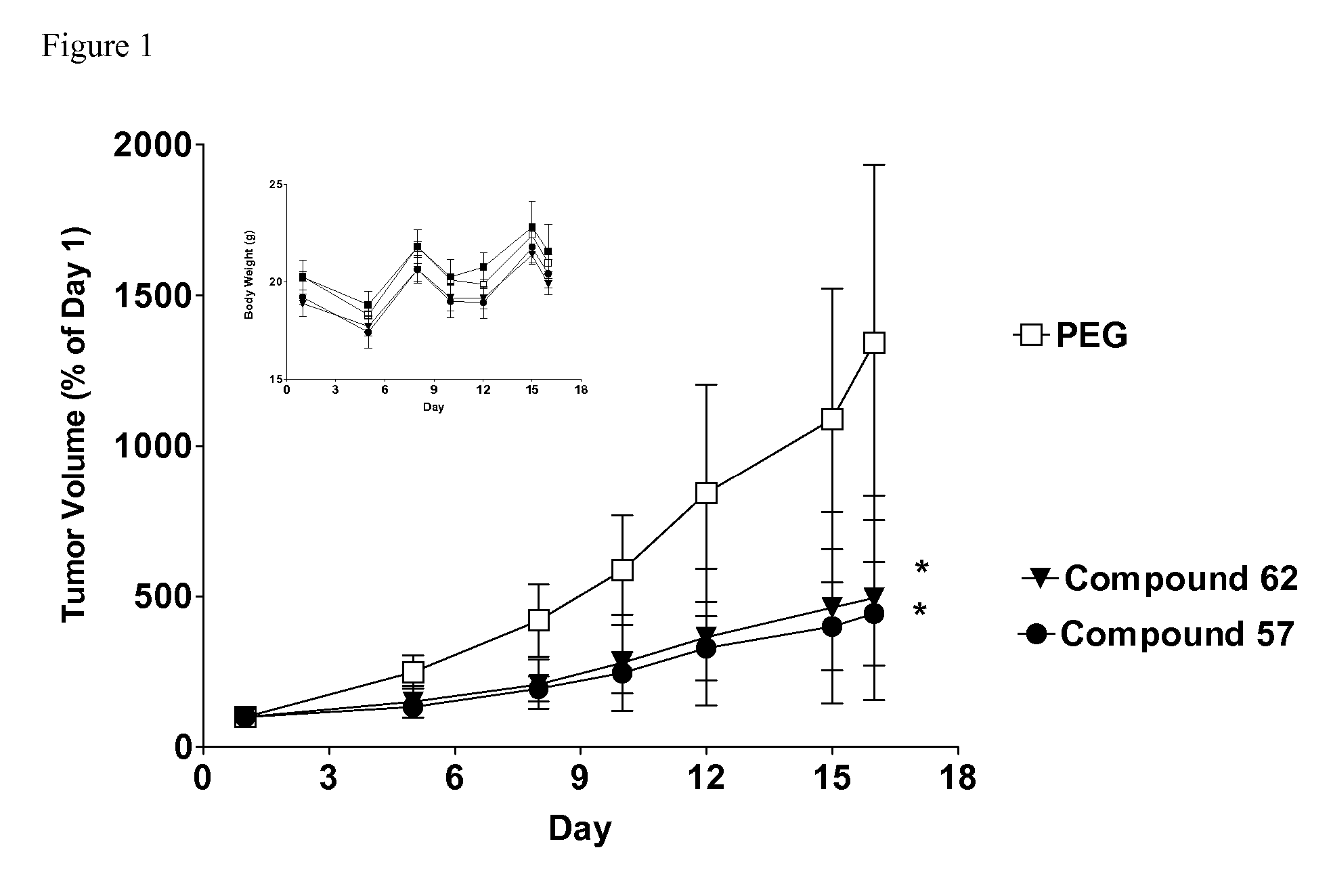Sphingosine kinase inhibitors
a kinase inhibitor and sphingosine technology, applied in the field of sphingosine kinase inhibitors, can solve the problems of inability to detect and inhibit sk, and inability to detect undesired effects in patients,
- Summary
- Abstract
- Description
- Claims
- Application Information
AI Technical Summary
Benefits of technology
Problems solved by technology
Method used
Image
Examples
example 1
Method for the Synthesis of 3-(4-chloro-phenyl)-adamantane-1-carboxylic acid (pyridin-4-ylmethyl)-amide, Compound 62
[0208] As an example, a process for the synthesis of Compound 62 is described in Scheme 1. The direct bromination of adamantane-1-carboxylic acid (1) in the presence of aluminum chloride (AlCl3) gave 3-bromide derivative (2) of 1 which was converted to (3) by the reaction of Friedel-Crafts reaction. 3 was reacted with thionyl chloride (SOCl2) to give 3-R-substituted-1-adamantanecarbonyl chlorides 4. By reaction 4 with a substituted amine, for example, 4-aminomethylpyridin (5), in THF, (6, also represented as Compound 62) and related amide compounds were obtained.
[0209] More specifically, adamantane-1-carboxylic acid (1) (45 g, 0.25 mol) was added to mixture of AlCl3 (45 g, 0.34 mol) and Br2 (450 g) at 0° C. and stirred at 0-10° C. for 48 hrs, kept 5 hrs at about 20° C., poured on to 500 g crushed ice, diluted with 300 ml CHCl3 and decolorized with solid Na2S2O5. The...
example 2
A Second Method for the Synthesis of Compound 62
[0213] A second method for the synthesis of Compound 62 and related adamantylamides is described in Scheme 2. 3-phenyl substituted intermediate (3) was prepared as described above. 3 reacted with 1,1′-carbonyldiimidazole (CDI) to give 3-R-substituted-1-adamantanecarbonylimidazole intermediate (4). By reaction of 4 with a substituted amine, for example 4-aminomethylpyridine 5, in toluene, 6 {3-(4-Chloro-phenyl)-adamantane-1-carboxylic acid(pyridin-4-ylmethyl)-amide} was obtained.
[0214] A diverse set of substituted aryladamantanes can be efficiently synthesized by condensation of various aromatic compounds with 2, and a variety of such compounds are commercially available. Additionally, amidation of 3 can be efficiently completed using a variety of coupling reagents and primary amine-containing compounds. The following Example provides several representatives of the products of this process; however, these methods can be adapted to pr...
example 3
Synthesis of Adamantylamides
[0215] The methods described in Example 1 or 2 were used to prepare a library of substituted adamantylamides. Data provided below include: the amount synthesized, the yield of the amidation reaction, the melting point (m.p.) of the compound, mass spectral (MS) data for the compound, and NMR spectral data for the compound.
Compound 1: 3-(4-Chloro-phenyl)-adamantane-1-carboxylic acid isopropylamide. Yield=81%; m.p.: 140-141.5° C.; MS m / z (rel intensity) 332 (MHz, 95).
[0216] Compound 2: 3-(4-Chloro-phenyl)-adamantane-1-carboxylic acid cyclopropylamide. 90 mg, Yield=78.3%; m.p.: 145-148° C.; 1H NMR(300 MHz, CDCl3) δ 0.44-0.46 (m, 2H, CH2), 0.76-0.78 (m, 2H, CH2), 1.59-1.92 (m, 12H, Admant-CH), 2.25 (s, 2H, Admant-CH), 2.62-2.65 (m, 1H, CH), 5.64 (m, 1H, HN), 7.28-7.30 (m, 4H, H-Ph); 13C NMR(300 MHz, CDCl3) δ 6.7, 22.7, 28.8, 35.5, 36.5, 38.4, 42.0, 44.5, 126.2, 128.1, 131.4, 148.2, 178.5; MS m / z (rel intensity) 330.46 (MH+, 100), 331.47 (25), 332.46(35).
[...
PUM
| Property | Measurement | Unit |
|---|---|---|
| Volume | aaaaa | aaaaa |
| Volume | aaaaa | aaaaa |
| Volume | aaaaa | aaaaa |
Abstract
Description
Claims
Application Information
 Login to View More
Login to View More - R&D
- Intellectual Property
- Life Sciences
- Materials
- Tech Scout
- Unparalleled Data Quality
- Higher Quality Content
- 60% Fewer Hallucinations
Browse by: Latest US Patents, China's latest patents, Technical Efficacy Thesaurus, Application Domain, Technology Topic, Popular Technical Reports.
© 2025 PatSnap. All rights reserved.Legal|Privacy policy|Modern Slavery Act Transparency Statement|Sitemap|About US| Contact US: help@patsnap.com



